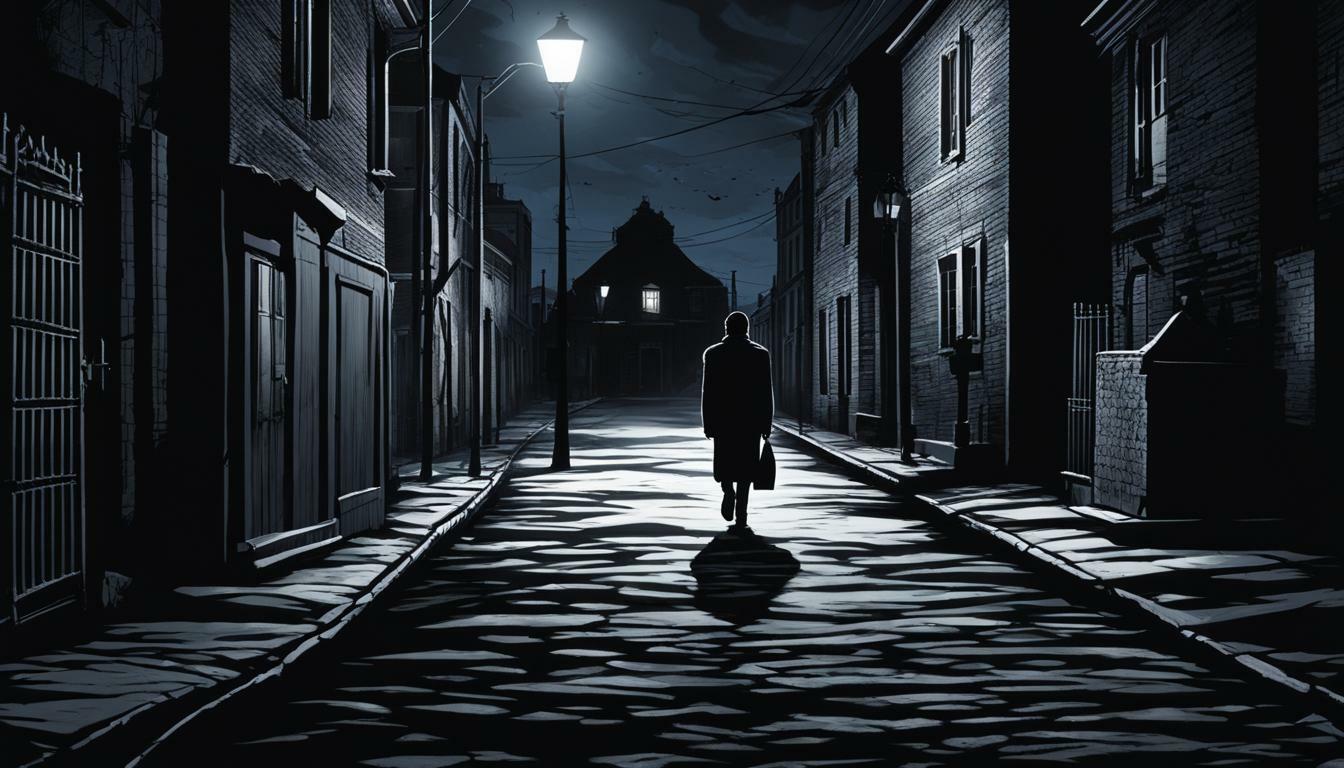As the sun sets and darkness engulfs the streets, many individuals experience a sense of unease and insecurity. This fear can be attributed to various factors, and understanding the reasons behind it can help us address and alleviate it. Let’s explore some of the potential reasons why we may feel unsafe at night.
One possible reason for feeling unsafe at night is a lack of visibility. The darkness creates an environment where it is harder to see potential threats, leading to increased feelings of vulnerability. This fear is often rooted in the idea that danger lurks in the shadows, making it important to find ways to improve lighting in public spaces and increase personal visibility through self-defense techniques.
Another factor that contributes to feeling unsafe at night is the fear of crime. Media coverage and personal experiences of crime can heighten our sense of vulnerability, even if statistics suggest that the actual risk may be low. It is essential to differentiate between perception and reality and to take proactive measures such as being aware of our surroundings, avoiding risky areas, and staying in well-lit areas to alleviate this fear.
A lack of trust in others can also play a role in feeling unsafe at night. This fear is often a result of previous negative experiences or stories we have heard about strangers or encounters gone wrong. Building trust and community connections can help to counteract this fear by creating a sense of support and security in our neighborhoods.
Personal safety concerns, such as the fear of harassment or assault, can also contribute to feeling unsafe at night. Women, in particular, may experience this fear due to higher rates of gender-based violence. Education on self-defense tactics, promoting consent and respect, as well as working towards gender equality can be helpful in reducing this fear.
It is essential to recognize that these fears are valid and that everyone’s experience of feeling unsafe at night may be unique. Addressing the underlying causes of this fear can involve various strategies such as improving lighting, promoting community cohesion, and raising awareness about personal safety.
Key Takeaways
- Feeling unsafe at night can be attributed to various factors, including a lack of visibility, fear of crime, lack of trust, and personal safety concerns.
- Proactive measures such as improving lighting, avoiding risky areas, and building community connections can help alleviate these fears.
- Education on self-defense tactics and promoting consent and respect can be helpful in reducing personal safety concerns.
The Fear of Crime: A Prevalent Factor
One prevalent factor contributing to feelings of insecurity at night is the fear of crime. Research has shown that crime rates are higher during nighttime hours, providing criminals with cover and creating a sense of vulnerability. This fear can have a profound impact on individuals’ behaviors and daily routines, leading to increased levels of stress and anxiety.
The media also plays a significant role in shaping and perpetuating the fear of crime. Sensationalized and exaggerated crime stories can contribute to a heightened fear and distorted perception of safety. This phenomenon, commonly known as the “mean world syndrome,” occurs when people believe that the world is more dangerous than it actually is due to media exposure.
Women, the elderly, and minority populations tend to have higher levels of fear compared to other groups. This can be attributed to a variety of factors, including personal experiences, societal stereotypes, and the perception of vulnerability.
Efforts to address the fear of crime are crucial in fostering safe and thriving communities. Implementing community policing strategies, increasing police visibility, and improving street lighting can help alleviate fears and enhance feelings of safety. Additionally, promoting social cohesion, providing support for crime victims, and empowering individuals can play a vital role in reducing the fear of crime.
In conclusion, the fear of crime is a prevalent factor that affects individuals and communities. It has far-reaching consequences for personal well-being, behavior, and mental health. Recognizing and addressing this fear is essential in creating safer environments and fostering resilient communities.
Lack of Visibility: Heightening Insecurity
Another aspect to consider is the lack of visibility during the nighttime. Reduced lighting and poor visibility in public spaces can create an environment where potential threats are harder to identify, and individuals may feel more vulnerable to physical harm.
This lack of visibility can contribute to feelings of insecurity, especially for those who are already anxious about their safety. It can lead to hypervigilance and general feelings of unease, making it difficult for individuals to relax and enjoy their surroundings.
Furthermore, lack of visibility can make it challenging to navigate unfamiliar areas, creating a sense of disorientation that can be unsettling. Even in familiar places, reduced lighting or obscured visibility can create shadows and dark spots that may appear threatening or ominous.
To address this issue, it is crucial to invest in increased lighting and surveillance systems in public spaces. This can help individuals feel more secure and reduce the potential for criminal activity. Additionally, community engagement programs and self-defense classes can help individuals feel empowered and capable of protecting themselves, contributing to a more secure environment overall.
In conclusion, addressing the issue of lack of visibility is crucial in reducing feelings of insecurity at night. By enhancing lighting and security measures and promoting personal awareness, individuals and communities can work together to create a safer and more inclusive environment.
Personal Experiences: Lingering Fear
Personal experiences and traumatic events can also play a significant role in feeling unsafe at night. Lingering fear is a topic that resonates with many individuals who have faced traumatic or frightening experiences. It refers to the persistent feelings of anxiety, unease, or apprehension that continue long after the initial event has passed. These feelings can be triggered by reminders, memories, or even subtle cues that serve as a constant reminder of the original fear-inducing situation.
One common personal experience that can result in lingering fear is surviving a natural disaster. Whether it be a hurricane, earthquake, or wildfire, individuals who have lived through these catastrophic events often find themselves haunted by the fear that it could happen again. The sound of thunder might trigger flashbacks to a past hurricane, or the smell of smoke can elicit anxiety due to its connection with a previous wildfire. These lingering fears can impact a person’s daily life, causing them to constantly worry about their safety and wellbeing.
Another personal experience that can lead to lingering fear is surviving a physical or emotional assault. Victims of such traumatic incidents may develop a deep-rooted fear of similar situations or individuals who remind them of their attacker. They may experience panic attacks, hypervigilance, and a constant state of anxiety, making it difficult to trust others and feel safe in the world. For these individuals, the fear can linger for years, impacting their ability to form new relationships or engage in normal activities.
Military veterans who have experienced combat are also no strangers to lingering fear. Post-traumatic stress disorder (PTSD) is a well-documented condition that often arises from the horrors of war. The fear experienced during combat can persist long after returning home, causing veterans to struggle with chronic anxiety, nightmares, and intrusive thoughts. The fear of loud noises, crowded spaces, or any trigger reminiscent of the battlefield can make it challenging for veterans to reintegrate into civilian life.
In addition to these specific personal experiences, lingering fear can also result from more general situations such as accidents, illness, or the loss of a loved one. People often develop a fear of driving after a car accident, even if they were not seriously injured. Likewise, individuals who have overcome a serious illness may live in fear of it returning, leading to constant worry and anxiety about their health. The death of a loved one can also leave individuals with a lingering fear of loss and abandonment, making it difficult for them to form new relationships or trust others.
To overcome lingering fear, many people turn to therapy or counseling. Techniques such as exposure therapy, cognitive-behavioral therapy (CBT), and eye movement desensitization and reprocessing (EMDR) can help individuals confront and process their fears in a safe and controlled environment. Additionally, support groups and self-help resources can provide individuals with the tools and community they need to navigate and manage their lingering fear.
In conclusion, personal experiences of lingering fear can have a profound impact on individuals’ lives. Whether related to surviving a natural disaster, enduring an assault, experiencing combat, or coping with general life events, the fear can persist long after the initial trauma. But with proper support and treatment, individuals can learn to overcome and manage their fears, allowing for a healthier and more fulfilling life.
Gender: A Heightened Vulnerability
Gender also plays a significant role in feelings of insecurity at night. Women, in particular, face a sense of vulnerability due to various societal factors that perpetuate gender-based violence and discrimination. Here are some key points to consider:
- Gender-based violence: Women and girls are particularly vulnerable to gender-based violence, including domestic violence, sexual assault, and harassment. These experiences can have severe physical, emotional, and psychological effects.
- Discrimination in the workplace: Women often face discrimination in the form of unequal pay, limited career opportunities, and biased treatment. This can perpetuate a cycle of economic vulnerability and dependency.
- Health disparities: Women may face specific health vulnerabilities due to biological factors, such as reproductive health issues and pregnancy-related complications. Cultural and social norms can also limit their access to healthcare services.
- Female genital mutilation (FGM): Some cultures practice FGM, exposing girls and women to severe health risks and long-term consequences. This harmful practice perpetuates gender-based vulnerability and violates human rights.
- Intersectionality: Gender vulnerability is enhanced when intersecting with other forms of oppression, such as race, class, and sexuality. For example, transgender individuals may face heightened vulnerability due to discrimination and lack of legal protections.
- Access to education: In many parts of the world, girls are disproportionately affected by limited access to education. Lack of education perpetuates gender inequality and vulnerability, limiting opportunities for socioeconomic empowerment.
- Vulnerability to poverty: Gender disparities contribute to women’s higher likelihood of living in poverty. Factors such as unequal pay, limited job opportunities, and societal expectations place women at a greater risk of economic instability.
- Political underrepresentation: Women’s political underrepresentation leads to the neglect of gender-specific issues and policies that address gender vulnerabilities. When decisions are made without considering gender perspectives, the needs and rights of women are often overlooked.
It is crucial to recognize and address gender vulnerabilities to promote social justice and equal opportunities for all genders. By challenging discriminatory norms and advocating for gender equality, societies can strive to create a safer and more inclusive environment for everyone.
Addressing Nighttime Insecurity: Building a Safer Environment
Efforts to address and unravel these fears have been made in many communities. One of the first steps in building a safer environment is to improve lighting infrastructure. Poorly lit areas are more susceptible to criminal activities, as they provide a sense of anonymity for wrongdoers. By installing adequate street lights and ensuring they are well-maintained, it becomes easier to detect suspicious activities and make individuals feel safer when walking or driving at night.
Another crucial aspect is enhancing community engagement. A strong sense of community can deter criminal activities and foster a supportive environment. Establishing neighborhood watch programs, encouraging community events, and fostering good relationships between residents and local law enforcement can go a long way in preventing nighttime insecurity.
Technology also plays a significant role in addressing nighttime insecurity. Utilizing surveillance cameras and motion sensors can provide an additional layer of security and assist in identifying perpetrators. Advanced systems and apps can help citizens report incidents promptly, ensuring a quick response from law enforcement authorities.
Furthermore, implementing effective transportation strategies can contribute to a safer nighttime environment. Enhancing public transportation services, improving street connectivity, and increasing the availability of reliable transportation options such as ride-sharing services can reduce the risk of nighttime insecurity.
Education and awareness campaigns are also essential in promoting nighttime safety. By educating the public about personal safety practices, such as staying in well-lit areas and traveling in groups, individuals can take active measures to protect themselves and their community.
Lastly, fostering a sense of inclusivity and accessibility is crucial in building a safer environment at night. Ensuring that public spaces are well-maintained, easily accessible, and accommodating to all individuals, including those with physical disabilities, promotes a feeling of safety for everyone.
In conclusion, addressing nighttime insecurity requires a multi-faceted approach that involves improving lighting infrastructure, enhancing community engagement, utilizing technology, implementing effective transportation strategies, conducting education campaigns, and fostering inclusivity. By implementing these strategies, we can work towards building a safer environment at night and mitigating nighttime insecurity in our communities.
FAQ
Q: What is the main factor contributing to feeling unsafe at night?
A: The fear of crime is a prevalent factor that contributes to feelings of insecurity at night.
Q: How does reduced visibility affect feelings of security at night?
A: Poor lighting and limited visibility in public spaces can make it difficult to see potential threats, thus heightening feelings of insecurity.
Q: Can personal experiences impact feelings of insecurity at night?
A: Yes, personal experiences, especially traumatic events, can create lasting fear and lead to hypervigilance and anxiety even in relatively safe situations.
Q: Do women experience a heightened sense of vulnerability at night?
A: Yes, women often experience a heightened sense of vulnerability due to societal factors such as gender-based violence and media representation.
Q: What efforts have been made to address nighttime insecurity?
A: Some efforts include increased lighting in public spaces, surveillance systems, community engagement programs, self-defense classes, and collective efforts to create safe spaces.





